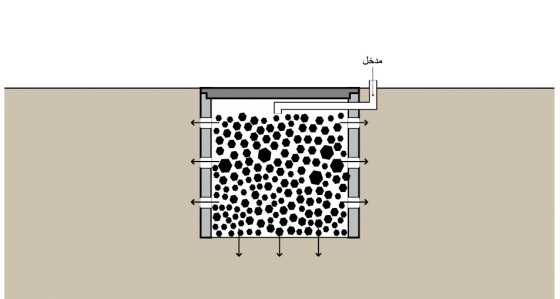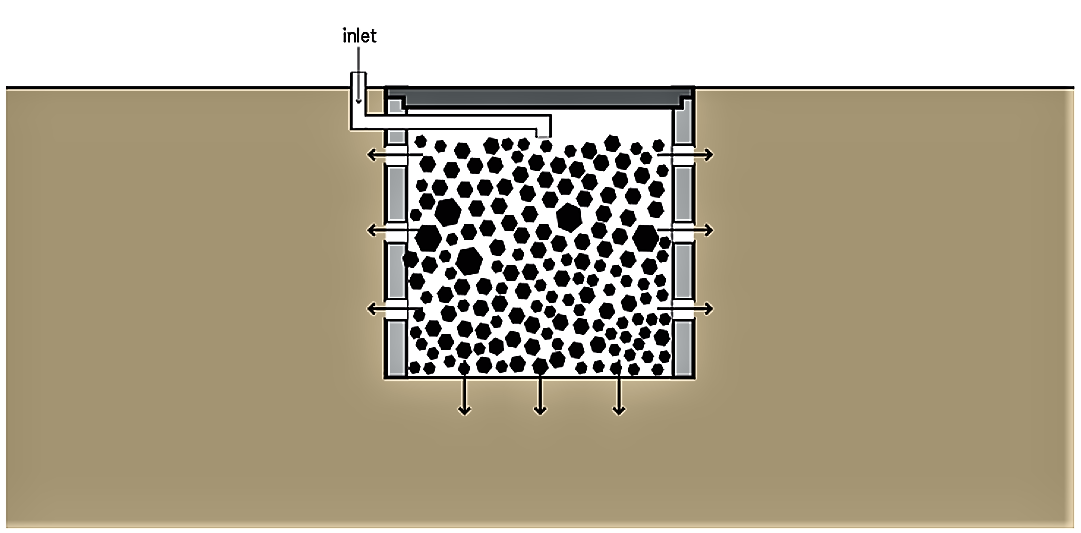حُفرة الامتصاص Soak Pit (أو حُفرة التصريف، أو حُفرة التشرب، أو بئر الترسيب) هي عبارة عن غرفة مغطاة، مسامية الجدران، وتسمح للمياه أن تتسرب ببطء إلى طبقات التربة. التدفقات السائلة الخارجة (المُعالجة) التي تم ترسيب محتوياتها مبدئيًا في إحدى تقنيات الجمع والتخزين/المُعالجة أو المُعالجة (شبه) المركزية، يتم تصريفها إلى غرفة تحت الأرض حيث يتم ارتشاحها إلى التربة المحيطة.
| المُدخلات | المُخرَجات |
|---|---|
التدفقات السائلة الخارجة , المياه الرمادية , البول , البول المخزن , مياه تنظيف الشرج |
- |

As wastewater (greywater or blackwater after primary treatment) percolates through the soil from the soak pit, small particles are filtered out by the soil matrix and organics are digested by microorganisms. Thus, soak pits are best suited for soil with good absorptive properties; clay, hard packed or rocky soil is not appropriate.

ينبغي أن تكون حُفرة الامتصاص على عمق بين 1.5 إلى 4 أمتار، ولكن بحكم التجربة يجب ألا يقل عمقها عن مترَين فوق منسوب المياه الجوفية. ويجب أن تكون على مسافة آمنة من مصادر مياه الشرب )في الحالة المثالية يجب أن تزيد عن 30 مترًا(. ينبغي أن تكون حُفرة الامتصاص بعيدة عن المناطق ذات حركة المرور الكثيفة حتى لا تكون التربة مُنضَغِطَة من فوقها وحولها. يُمكن أن تُترك الحُفرة فارغة ومبطنة بمادة مسامية لدعم جسم الحُفرة ومنعها من الانهيار، أو تُترك غير مُبطنة وتُملأ بالحصى والصخورالخشنة. الصخور والحصى ستمنع الجدران من الانهيار ولكنها لا تزال توفر مساحة مناسبة لمياه الصرف. في كلتا الحالتين، ينبغي فرش طبقة من الرمل والحصى الناعم في القاع لتساعد على تشتيت التدفق. للسماح للوصول للحُفرة في المستقبل، ينبغي استخدام غطاء قابل للرفع )يُفضَّل أن يكون من الخرسانة( لإغلاق الحُفرة إلى أن يكون هناك حاجة لصيانتها.
المُلاءَمَة
حُفرة الامتصاص لا توفر المُعالجة الكافية لماء الصرف الخام، وسيتم انسدادها سريعًا. كما يجب أن تُستخدم لصرف المياه السوداء التي تم ترسيب محتوياتها أو المياه الرمادية.
تُعتبر حُفر الامتصاص مناسبة للتجمعات الريفية أو شبه الحضرية. وهي تعتمد على تربة ذات قدرة امتصاص كافية. وهي ليست مناسبة للمناطق المُعرضة للفيضانات أو ذات المنسوب المرتفع للمياه الجوفية.
تُترك حُفرة الامتصاص ذات الحجم الجيد بدون صيانة لفترة ما بين 3 إلى 5 سنوات. ولزيادة عُمر الحُفرة ينبغي التأكد من أن التدفقات السائلة الداخلة للحُفرة تم ترويقها و/أو ترشيحها لمنع التراكم المفرط للمواد الصلبة.
ستُحدث الجسيمات والكتل الحيوية في نهاية المطاف انسدادًا في الحُفرة، وذلك يتطلب التنظيف والإزالة. وعندما تتدهور كفاءة الحُفرة، يمكن تفريغ موادها الداخلية وإعادة ملئها من جديد.
حلول تقنيات وممارسات افضل للصرف الصحى دليل الاحياء الهاشمية فى نواكشوط -موريتانيا
المياه ،الصرف الصحي النظافة الصحية وظروف الإقامة في السجون
التلوث : المخاطر والحلول
بناء الحمامات وطرق تحسينها وصيانتها
A Comparison of Wash Area and Soak Pit Construction
This Master Thesis describes the implementation of a soak pit and a wash area in a rural area next to the city Sikasso in West Africa. This detailed report describes how to built and how to dimension a soak pit and covers also social, technical and economic aspects.
AHRENS, B. (2005): A Comparison of Wash Area and Soak Pit Construction. The Changing Nature of Urban, Rural, and Peri-Urban Linkages in Sikasso, Mali (Master Thesis). Michigan Technological University URL [Accessed: 23.02.2010]Ecosan Curriculum 2.3
Low-cost Urban Sanitation
This book covers the public health, technical, socioeconomic, sociocultural and institutional aspects of sanitation in towns and cities of developing countries. The text features excreta-related diseases and the use of sanitation to reduce their transmission. The sanitation technologies covered in detail are VIP latrines, pour-flush toilets, septic tanks, settled sewerage and simplified sewerage, with additional chapters on sullage disposal, pit emptying, and sewage treatment and reuse. Sociocultural constraints on sanitation systems and their socioeconomic costing are described, together with hygiene education, which is essential in order to achieve maximum benefits to health. The text also explains how to choose the most appropriate sanitation option for a given low-income community. Finally, institutional aspects are reviewed, including effective sanitation programme planning, monitoring and evaluation.
MARA, D. (1996): Low-cost Urban Sanitation. United Kingdom: WileySeptic Tank Guidelines
This document on septic tanks gives guidelines on how to design and make a system.
OXFAM (2008): Septic Tank Guidelines. (= Technical Brief ). Oxford: OXFAM URL [Accessed: 08.04.2014]Disposal of septic tank effluent
This paper presents a review on the septic tank and septic systems. Information on design and functional aspects, and environmental effects of septic tank systems are presented. Chapter 6.2 is about the disposal of septic tank effluent.
POLPRASERT, C. RAJPUT, V.S. (1982): Disposal of septic tank effluent. المُدخلات: POLPRASERT, C. ; RAJPUT, V.S. ; (1982): Septic Tank and Septic Systems. Bangkok: 31-58. URL [Accessed: 14.04.2014]Compendium of Sanitation Systems and Technologies. 2nd Revised Edition
This compendium gives a systematic overview on different sanitation systems and technologies and describes a wide range of available low-cost sanitation technologies.
TILLEY, E. ULRICH, L. LUETHI, C. REYMOND, P. ZURBRUEGG, C. (2014): Compendium of Sanitation Systems and Technologies. 2nd Revised Edition. Duebendorf, Switzerland: Swiss Federal Institute of Aquatic Science and Technology (Eawag) URL [Accessed: 28.07.2014] PDFCompendium of Sanitation Systems and Technologies (Arabic)
This is the Arabic version of the Compendium of Sanitation Systems and Technologies. The Compendium gives a systematic overview on different sanitation systems and technologies and describes a wide range of available low-cost sanitation technologies.
TILLEY, E. ULRICH, L. LUETHI, C. REYMOND, P. SCHERTENLEIB, R. ZURBRUEGG, C. (2014): Compendium of Sanitation Systems and Technologies (Arabic). 2nd Revised Edition. Duebendorf, Switzerland: Swiss Federal Institute of Aquatic Science and Technology (Eawag) PDFLow-cost Urban Sanitation
This book covers the public health, technical, socioeconomic, sociocultural and institutional aspects of sanitation in towns and cities of developing countries. The text features excreta-related diseases and the use of sanitation to reduce their transmission. The sanitation technologies covered in detail are VIP latrines, pour-flush toilets, septic tanks, settled sewerage and simplified sewerage, with additional chapters on sullage disposal, pit emptying, and sewage treatment and reuse. Sociocultural constraints on sanitation systems and their socioeconomic costing are described, together with hygiene education, which is essential in order to achieve maximum benefits to health. The text also explains how to choose the most appropriate sanitation option for a given low-income community. Finally, institutional aspects are reviewed, including effective sanitation programme planning, monitoring and evaluation.
MARA, D. (1996): Low-cost Urban Sanitation. United Kingdom: WileyHow to Select Appropriate Technical Solutions for Sanitation
The purpose of this guide is to assist local contracting authorities and their partners in identifying those sanitation technologies best suited to the different contexts that exist within their town. The first part of the guide contains a planning process and a set of criteria to be completed; these assist you in characterizing each area of intervention so that you are then in a position to identify the most appropriate technical solutions. The second part of the guide consists of technical factsheets which give a practical overview of the technical and economic characteristics, the operating principle and the pros and cons of the 29 sanitation technology options most commonly used in sub-Saharan Africa.
MONVOIS, J. GABERT, J. FRENOUX, C. GUILLAUME, M. (2010): How to Select Appropriate Technical Solutions for Sanitation. (= Six Methodological Guides for a Water and Sanitation Services' Development Strategy , 4 ). Cotonou and Paris: Partenariat pour le Développement Municipal (PDM) and Programme Solidarité Eau (pS-Eau) URL [Accessed: 19.10.2011]Disposal of septic tank effluent
This paper presents a review on the septic tank and septic systems. Information on design and functional aspects, and environmental effects of septic tank systems are presented. Chapter 6.2 is about the disposal of septic tank effluent.
POLPRASERT, C. RAJPUT, V.S. (1982): Disposal of septic tank effluent. المُدخلات: POLPRASERT, C. ; RAJPUT, V.S. ; (1982): Septic Tank and Septic Systems. Bangkok: 31-58. URL [Accessed: 14.04.2014]Compendium of Sanitation Systems and Technologies. 2nd Revised Edition
This compendium gives a systematic overview on different sanitation systems and technologies and describes a wide range of available low-cost sanitation technologies.
TILLEY, E. ULRICH, L. LUETHI, C. REYMOND, P. ZURBRUEGG, C. (2014): Compendium of Sanitation Systems and Technologies. 2nd Revised Edition. Duebendorf, Switzerland: Swiss Federal Institute of Aquatic Science and Technology (Eawag) URL [Accessed: 28.07.2014] PDFA Comparison of Wash Area and Soak Pit Construction
This Master Thesis describes the implementation of a soak pit and a wash area in a rural area next to the city Sikasso in West Africa. This detailed report describes how to built and how to dimension a soak pit and covers also social, technical and economic aspects.
AHRENS, B. (2005): A Comparison of Wash Area and Soak Pit Construction. The Changing Nature of Urban, Rural, and Peri-Urban Linkages in Sikasso, Mali (Master Thesis). Michigan Technological University URL [Accessed: 23.02.2010]Septic Tank Guidelines
This document on septic tanks gives guidelines on how to design and make a system.
OXFAM (2008): Septic Tank Guidelines. (= Technical Brief ). Oxford: OXFAM URL [Accessed: 08.04.2014]Ecosan Curriculum 2.3
http://www.epd.gov.hk/epd/english/environmentinhk/waste/guide_ref/guide_lwc_scheme_sub6_ss5.html
On the website of the Hong Kong Environmental Protection Department, guidelines for soakaway systems are published.

